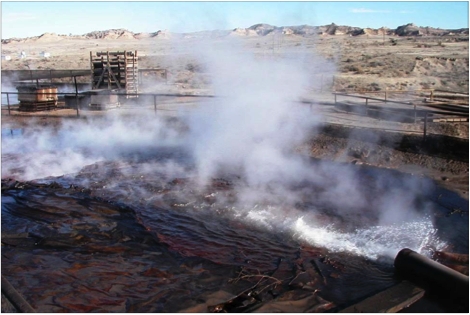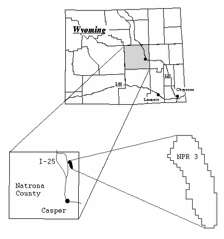Archive for the 'Fossil Power' Category
Coal backlash
With the announced acquisition of TXU earlier this week, Fortune magazine has published a story analyzing the future of coal.
Coal fired electric generation accounts for 48.8% of US electricity production. Of the fossil fuel choices, coal is the least expensive and most plentiful of fuels, costing just $1.67 per million BTUs, though the price is up from $1.20 per million BTUs in the year 2000. To bring the BTUs measurement home, 1,000,000 BTUs is equivalent to around 293 kilowatt hours, enough to power a small home in the US for a month. Experts claim there is a coal reserve in the US of around 1.3 million square kilometers (~500,000 square miles) that should last at current burn rates for around 250 years. At present, there are some 150 new coal fired plants in planning through construction phases in the US.
Every 1,000,000 watt/hours of power produced by coal results in 1,000 kg (2,200 lbs) of carbon dioxide and 15 kgs of sulphur and nitrogen oxides into the atmosphere. Coal mining happens in one of two ways, shaft mining and strip mining. Shaft mining is just what it sounds like, a shaft is sunk into the earth at some angle and the coal vein is followed underground with the coal being transported out of the mine for processing. Strip mining works for shallow veins where the non-coal material (overburden) is removed to access the coal vein which is removed and processed, and then the overburden is replaced and the land is reclaimed.
New research is underway to make coal cleaner and less damaging to the atmosphere including gassification and carbon sequestration technologies. Gassification is happening to some extent now and carbon sequestration may or may not work – the idea of capturing the carbon post burn and injecting it into the earth for storage sounds a little farfetched until one thinks about how natural gas is stored. There are several large salt domes that have been hollowed out by pumping in water to dissolve the salt then the resulting brine is pumped out leaving a chamber. Natural gas is then injected and stored in these reserviors. I don’t know if that’s exactly what researchers have in mind for carbon dioxide, but there is an existence proof of some sort.
These facts are important when considering the future of coal. Environmental objection is but one variable in the coal equation, and perhaps the least important when considering how to positively impact climate change. Another variable is cost, the most important and most influential variable. I believe cost is the key. Until and unless coal generated electricity becomes more expensive to produce other energy sources will not be sought with the vigor that is required to make a large impact.
The good news is, we can already see the cost factor coming into play. The TXU plants on the docket are slated to cost on the order of $1B a piece, or about $1M per megawatt of generation capability. Natural gas costs $0.75M per megawatt. Wind costs $1M per megawatt, but it’s not baseload power due to the fickle nature of wind. Solar is still a couple of technology generations away costing around $8M megawatt, it also suffers from capacity factor, it’s not generating power at night. Geothermal power is baseload, but with exploration costs included, it comes to $2.5M per megawatt. Geothermal exclusive of exploration is in the $1M per megawatt range. Coal gassification plants come in at around $2.5M per megawatt now and who knows what carbon sequestration will add in terms of cost. As you can see, coal plant construction prices are starting to encroach on renewable plant cost territory.
Operations costs are also creeping higher. The more stringent the emissions regulation, the more expensive it becomes to operate a coal fired plant. If we add in the cost of fuel over the 40 year lifetime of a plant, all of the sudden baseload renewable generation like geothermal looks pretty darned attractive.
That brings us to the most important variable, emissions regulation (which will be the largest single driver of coal electricity production cost.) A policy the new Congress could take on is to mandate new coal plants to have emissions no greater than a geothermal plant (I’ll accept 1980’s vintage Geysers plants as the benchmark even though new binary plants in a closed system would be better.) This would serve notice that investment must go into clean electricity generation and would have lasting impact over the next 20 years on climate change.
One thing is certain, market forces alone are not enough to tip the investment from coal to other clean technologies. The market needs a push in the form of strict emissions control which will cause the price of coal generation to rise sufficiently to cause alternate behaviors. Now is the time.
If you liked this entry, Digg It!
Technorati Tags: Energy | Coal | Emissions
KKR led consortium acquires TXU
In what can only be described as a mega-deal, investment firm Kohlberg, Kravis, Roberts, & Co. are paying a 15% premium over market close, $69.25 per share, to take TXU Corp private. The $31.8 billion dollar deal is the largest ever to take a company private.
Why do we care? Simple, as a consequence of the takeover, TXU’s planned 11 mega-coal plants will be reduced to 3 as a result of the acquisition and stronger environmental policies are likely to be enacted. The reduction will displace some 56 million tons of carbon emissions, equivalent to preventing 10.2 million new cars from appearing on the road.
This is an interesting development to be sure. Let’s hope the focus shifts from coal to other, less polluting generation mechanisms as a private company. But axing 8 planned coal plants is a good start.
If you liked this entry, Digg It!
Technorati Tags: Energy | Megadeal | TXU Buyout
Geothermal Co-production with Petroleum?
Here’s something interesting you may not know: when harvesting oil, there is often “waste water” mixed in the substance coming out of the hole, frequently the water is under pressure and hot. While at the Stanford Geothermal Conference last month, Mark Milliken covered this information during his talk.
Waste Water Discharge at Naval Petroleum Reserve #3

The Naval Petroleum Reserve #3 is really part of the Department of Energy’s Rocky Mountain Oilfield Test Center. As such, it’s not bound by the economic realities of having to produce or else and can experiment a bit with new drilling techniques as well as ponder the question: “what should we do with all this hot water?”
NPR #3’s location in Wyoming

At this particular site, some 6.4 million liters (1.7M gal) of 87°C (190°F) water is discharged per day as part of their oil production. This water is routed into a cooling pond and then released into Little Teapot Dome Creek when the water has cooled sufficiently. Curiously, the amount of oil produced from this activity is around 48,000 liters (12,600 gal) per day. As you can see, far more water is produced per day than oil! The raw power equivalent of this water is estimated to be 22MW, or enough to power some 25,000 homes per year. But, a small fraction of that raw power is available for harvest with existing technologies.
Where does all this hot water come from? The water is hypothesized to come from the Big Horn Mountain range where it soaks into the earth and descends to a series of hot rocks. It then migrates to the Powder River Basin and pours into fissures in Ten Sleep and Madison Limestone layers where it is extracted during petroleum operations. The heat map below will provide some context for how the NPR #3 site fits into the overall estimated heat flow at a 3km depth.
US Heat Map 3km depth

Using binary systems to extract the heat from this water could easily yield a couple of hundred kilowatts in a binary generation scheme. These units need around a 50°C (120°F) difference in temperature between the ambient temperature of production and the resource. It would seem likely that this could be established and maintained at this site and many others. It’s interesting to see this type of exploration underway and it could provide additional benefit (both ecologically and economically) to take advantage of this “free” by-product of an existing activity.
If you liked this entry, Digg It!
Technorati Tags: Energy | Geothermal | Oil
Exxon CEO says oil prices inflated by supply disruptions
In an article about world oil prices posted on CNN yesterday, Exxon CEO Rex W. Tillerson, is quoted “Crude prices in New York would be around $40-$45 a barrel without the risk of supply disruptions.” That may be true, but if we look at recent price history, that’s still 2x what crude was selling for in 2002. Check the chart below which has the average price of crude oil per barrel.

I believe that market demand, not only from the US, but globally continues to increase while supply stays relatively flat. That’s a sure fire recipe for price increase. Yes, more oil reserves are being discovered, but each successive discovery is more expensive to harvest. Make no mistake about it, oil is never going to be “cheap” again.
If you liked this entry, Digg It!
Technorati Tags: Energy | Oil Price | Supply Disruption
Speaking of big ideas…
The Oil Drum published this long and detailed entry from the Engineer Poet on how to replace our dependence on fossil fuel and get to carbon neutrality using an enhanced biomass system coupled with electricity generation, fuel cells, and battery transport power. If you don’t have time for a long read, are data averse, or have attention deficit, the referenced post might not be for you…
This is an old post by net standards, published at the end of November of last year, but certainly is filled with interesting data. Now I don’t subscribe to the “solve the energy crisis in one fell swoop” approach, but this post did make me think that perhaps more is possible in big hunks than I’ve been allowing. Even so, this is is a grandiose proposal that would require 20 years or more to implement, if it even could be implemented. But the ideas are worth exploring as realizing even 10% of the benefit would make a difference.
The thesis of the post is: “The US can replace our fossil fuel dependence with sustainable fuel and positively impact our carbon footprint – but, not with our current approach, assumptions, or reward system.” The author then goes on to outline at length why our current situation and approach is flawed, current consumption and conversion of energy to work, outlines an improvement using biomass with several outputs including charcoal, ethanol, and electricity, tackles the issue of carbon capture from the atmosphere, then outlines plans for electricity and transportation, and finally ties it all together.
If you’re at all interested in this subject area, this is must-read content. Thanks to Bruce for passing this along.
If you liked this entry, Digg It!
Technorati Tags: Biomass | Carbon Capture | Comprehensive Plan








